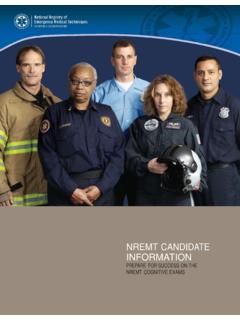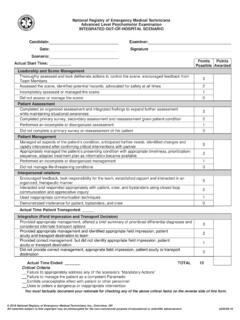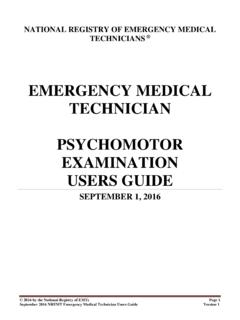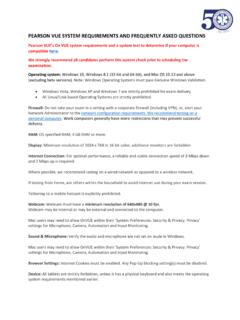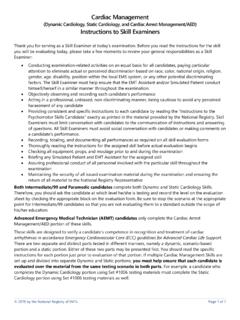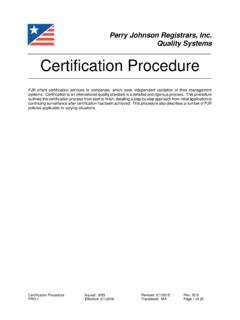Transcription of Agency Guide for Recertification - content.nremt.org
1 Agency Guide for Recertification Updated: October 2017 COPYRIGHT 2017 NATIONAL REGISTRY OF EMERGENCY MEDICAL TECHNICIANS, INC. 6610 Busch Boulevard Box 29233 Columbus, OH 43229-0233 (614) 888-4484 All Rights Reserved. COPYRIGHT WARNING: This manual is protected by Copyright laws of the United States of America. Only non-commercial reproduction of this material for educational purposes or the advancement of medical science is permitted. No part of this manual may be reproduced, stored in a retrieval system, or transmitted, in any form or by any means, electronic, mechanical, photocopying, recording, or by any other means whatsoever.
2 Violators will be subject to prosecution and other actions. Suggested Citation: National Registry of Emergency Medical Technicians (2017). National Continued Competency Program: Training Officers Guide . NREMT. Retrieved from The vision of the National Registry of Emergency Medical Technicians (NREMT) Recertification Department is to provide customer support to Training Officers, Medical Directors, and providers while validating that the EMS Professionals have maintained continued competence through education and practice for quality patient care to ensure public safety. Embracing this vision, it is the intent of the Recertification Department to present this Guide to serve as a resource for agencies, training officers, medical directors, and other stakeholders who may benefit.
3 The NREMT is committed to protection of the public by offering ongoing improvements in the Recertification process and updating guidelines that will favorably impact EMS for many years to come. Specifically, the National Continued Competency Program incorporates the use of evidence-based medicine, gives state and local agencies the freedom to dictate a portion of their education requirements, and provides a foundation for EMS professionals to embrace life-long learning. The NREMT wishes to extend our sincere gratitude to the State EMS Offices, Agencies, Training Officers, Medical Directors, and EMS Professionals who are committed to maintenance of provider certification through the established guidelines and uniform standards set forth by the NREMT.
4 Table of Contents Brief History of National EMS Continued Principles and Application of the Continued Competency Overview of the National Continued Competency National 2016 National Component 2012 National Component Local Individual Recertification Active and Inactive Certification General Recertification Transition Acceptable Continuing Education Available Resources for Training Officers and Medical Frequently Asked 5 2017 National Registry of Emergency Medical Technicians, Inc., Columbus, OH All materials subject to this copyright may be photocopied for the non-commercial purpose of educational or scientific advancement.
5 BRIEF HISTORY OF NATIONAL EMS CONTINUED COMPETENCY Since the registration of the first nationally certified EMS professional in 1971, EMS practice has evolved significantly. Over the last four decades, the EMS profession has advanced from fundamental methods of care and transportation, to the delivery of more advanced emergency medicine in the out-of- hospital environment. It is with the changes in the EMS scope of practice, the Practice Analysis, development and inclusion of evidence-based guidelines, and shifting community based needs which helps drive the importance of continued competency and maintenance of certification. The 2007 release of the National EMS Scope of Practice Model identified four levels of provider care: Emergency Medical Responder Emergency Medical Technician Advanced Emergency Medical Technician Paramedic Further, in 2009 the National EMS Education Standards were completed.
6 These standards outlined education necessary to bring entry level providers to a competency level recognized in the National EMS Scope of Practice Model. The NREMT has utilized the Traditional Model of Recertification since the 1980s when Recertification requirements were based on the premise that all providers completed the same clock hours of training. While there was some flexibility to adapt some training to local needs, the Recertification process did not provide a formal pathway for adaptability. Refresher content areas did not prescribe training over areas of practice where significant change had occurred. Lastly, there was no ability for medical directors and systems to focus training on needs identified by the continuous quality improvement process.
7 As a result, the need for a new, more contemporary model of Recertification was created. PRINCIPLES AND APPLICATION OF THE CONTINUED COMPETENCY PROGRAM In 2010, a task force met to consider revisions of the NREMT s Recertification process. The task force was a multi disciplinary group comprised of representatives of the major regulatory, medical oversight and operational components of Emergency Medical Services. During the 2000 s continued competency was being addressed as a necessity for all medical specialties. The ongoing work of the American Board of Medical Specialties (ABMS) was reviewed by the task force. In summary, the NREMT s continued competency task force selected five key principles identified by ABMS that were adopted and included in the Recertification process for National EMS Certification.
8 These 5 principles include: 1. Professional Standing 2. Practice Performance 3. Life Long Learning 4. Individual Continuing Education 5. Self-Assessment* *Self-Assessment was originally adopted and included in the early stages of the NCCP Recertification model and is no longer required. 6 2017 National Registry of Emergency Medical Technicians, Inc., Columbus, OH All materials subject to this copyright may be photocopied for the non-commercial purpose of educational or scientific advancement. 1. Professional Standing For an individual to hold National EMS Certification the individual must not be barred from licensure/certification in any state.
9 Holding a current valid license/certification is a critical element to assure the public that EMS providers have not faced any action that would bar them from practice. The NREMT requires disclosure of any criminal convictions or licensure/certification limitations as part of the certification and Recertification requirements. The NREMT has adopted a Criminal Conviction Policy to safeguard the public from individuals who, in practice as an EMS professional, might pose a danger to the public. All applicants for certification or Recertification must disclose any criminal conviction as required on an application. The NREMT may deny an applicant eligibility to sit for a certification examination, deny certification, suspend or revoke an individual s certification, or take other appropriate action with respect to the applicant s certification or Recertification based on an applicant s felony criminal convictions and all other criminal convictions (whether felony or misdemeanor) relating to crimes involving physical assault, use of a dangerous weapon, sexual abuse or assault, abuse of children, the elderly or infirm and crimes against property, including robbery, burglary and felony theft.
10 You may review further information related to this policy at 2. Practice Performance Each EMS system across the nation has evolved to meet the individual needs of the community or region it serves. National EMS Certification requires competency and education at the local level to best serve specific state and community needs. Continued competency to practice may be validated by psychomotor or skills assessments and other performance measurement tools. Validation of practice performance is the responsibility of the provider s EMS supervisor or training officer at the EMR and EMT levels and validated by the provider s physician medical director at the Intermediate, AEMT and Paramedic levels for active certification.


